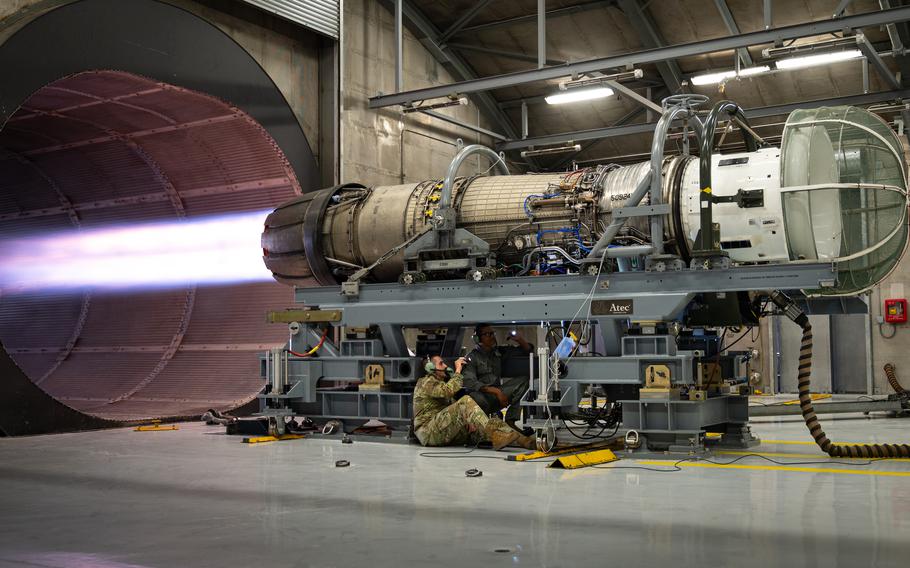
Checks are performed as an afterburner blasts from a General Electric F110 jet engine, used to power an F-16 Fighting Falcon, during an engine test run at Hill Air Force Base, Utah, June 2025. (Micah Garbarino/U.S. Air Force)
In an age defined by global competition, geopolitical uncertainty and technological interdependence, the strength and resilience of the United States’ defense and aerospace manufacturing base are more critical than ever. At the heart of this industrial ecosystem lies the jet engine —a technological marvel that powers both military and commercial aviation. But behind the roar of every fighter jet or transcontinental aircraft is a complex, globally interwoven supply chain that is increasingly vulnerable to disruption. The dangers facing the U.S. jet engine supply chain today are not just economic; there are a number of strategic threats that put our national security, economic stability and technological superiority at risk.
Jet engines are among the most intricate machines ever devised, often comprising tens of thousands of precision-engineered components sourced from a global network of suppliers, including nearly 1,500 in the United States. This includes everything from rare earth magnets to high-temperature alloys, single-crystal turbine blades, microelectronics, and complex software systems. While globalization has allowed for cost efficiencies and access to diverse expertise, it has also exposed critical nodes of the supply chain to geopolitical risk, trade disruptions, cyber threats, and capacity bottlenecks.
Even now, years after the initial shock of COVID-19 pandemic, production backlogs persist in both commercial and military engine production — particularly in the availability of forgings, castings and specialty materials essential for jet engine assembly. A recent report of the top 100 global Aerospace and Defense (A&D) manufacturers reported that backlogs for new aircrafts and systems topped 14,000 units, equal to a decade of output, and delivery times are now delayed by years. If a single supplier of a unique component falters, the effects ripple throughout the entire chain, delaying aircraft deliveries, grounding fleets, and undermining military readiness.
A significant portion of the U.S. jet engine supply chain, a $31 billion market, remains dependent on foreign sources, particularly for raw materials like titanium and rare earth elements. China, which controls approximately 70% of global rare earth processing capacity, poses a potentially stark risk. In a future scenario where diplomatic tensions escalate or trade restrictions tighten, the U.S. could find itself cut off from essential materials required for not just jet engines, but everything from radar systems to medical and scientific instruments.
Russia has historically been the major supplier of aerospace-grade titanium, and the invasion of Ukraine — and subsequent sanctions — have prompted urgent questions about the long-term sustainability of relying on adversarial or unstable regimes for critical inputs. That is why it is more important than ever to shore up our relationships with allies that can provide an alternative in the supply chain.
Another danger lies in the erosion of skilled labor and institutional knowledge. The aerospace industry in the United States faces an aging workforce, with a significant portion nearing retirement. At the same time, fewer young workers are entering technical and engineering fields. This brain drain threatens not just manufacturing capacity but innovation itself.
The loss of small-to-medium enterprises (SMEs), often family-owned and operating on tight margins, poses a hidden but potent threat. These businesses manufacture niche parts that may not be easily replicated by larger firms or alternative sources.
In a digitized world, the security of the jet engine supply chain also extends to the digital domain. Sophisticated adversaries have repeatedly targeted U.S. aerospace firms through cyber attacks aimed at stealing intellectual property or sabotaging production. The theft of proprietary engine designs by state-sponsored actors has already been documented and continues to represent a critical vulnerability.
Additionally, ransomware and malware attacks on small suppliers can paralyze production and lead to widespread delays. Many of these smaller firms lack the effective cyber security infrastructure of prime contractors like Raytheon or GE Aerospace, making them attractive — and easy — targets for cybercriminals and hostile nations alike.
The good news is that the dangers facing the jet engine supply chain are not insurmountable. During these challenging times some of our largest defense companies are already taking the necessary steps to limit production delays and supply chain risk. But addressing them requires focused, coordinated action across government, industry and academia.
Public-private partnerships can play a key role in establishing strategic stockpiles of rare materials, creating redundancy in production, and accelerating innovation in alternative materials and manufacturing processes such as additive manufacturing (3D printing).
The Defense Production Act should be utilized more aggressively to onshore critical manufacturing capabilities and support vulnerable suppliers.
Cyber security must be treated as a fundamental component of supply chain integrity. Federal programs should help small and mid-sized aerospace firms upgrade their defenses, while imposing stringent cyber security standards across the entire network.
The jet engine symbolizes American innovation, power and progress. But without a resilient supply chain, that power is compromised. The U.S. must move swiftly to secure its jet engine industrial base before the next crisis strikes — because in matters of air superiority and national defense, failure is not an option.
Scott Vadnais, a Nebraska-based retired Air Force officer, served in dozens of countries. He is a former senior strategic planner at General Dynamics Information Technologies.